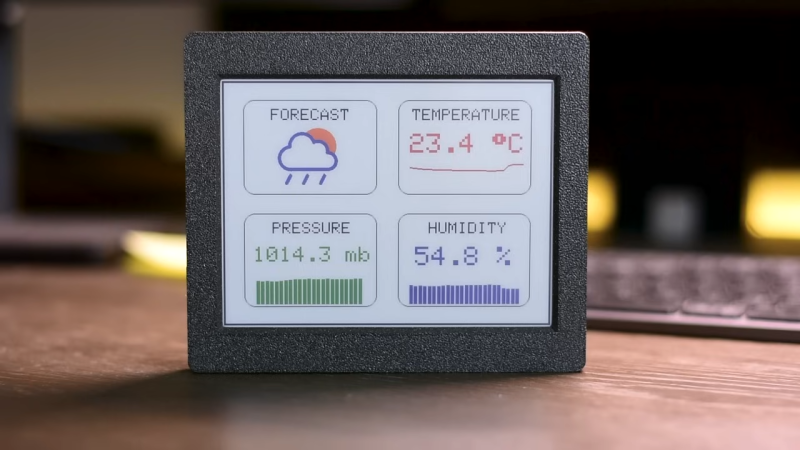[educ8s.tv] has built weather stations before, but his latest is his best yet. It’s all thanks to its low-power design, enabled by its e-paper display.
The build is based around an ESP32 microcontroller, combined with a BMP180 sensor for measuring barometric pressure, and a DHT22 sensor for measuring temperature and humidity. By taking these values and feeding them into the Zambretti algorithm, it’s possible to generate a rudimentary weather forecast.
The weather station looks particularly impressive thanks to its six-color e-paper display. It’s brightly colored and easy to read, and displays graphs of temperature, pressure, and humidity over time. Plus, by virtue of the fact that it only draws power when updating, it allows the project to last a long time running solely on battery power.
As far as DIY weather stations go, this is an attractive and clean design that offers plenty of useful data to the user. We’ve seen some other neat builds in this vein before, too.

















First, I want to say, the DHTxxs are terrible sensors. They should be forbidden by Government. Every Government. Worldwide.
But ok, they use bme280 in this project as an alternative. So please, use that! Burn you DHTxx.
The cheap e-paper-thingy (110 €, it is a steal for a 5.85-inch 600×488 pixel 7 color display…) is nice, has all the esp32 on it. Makes it an easy project.
They missed one change of saving a nuance of power: supply the sensor with power via a GPIO port. esp32 has 40 mA, that is way more this Bosch sensors needs (3.6 μA @ 1 Hz!)
They did the software quite nicely. Every some minutes to wake up for the sensors without WiFi, not so often wake up to do the forecast with WiFi. I’m not so sure about the equidistant wake-ups. Forecast during sleep time could be less often, during daytime more often to not miss a fast weather change… Here in Germany we have NINA and the question is: how often to wake up and poll their API not to miss an alarm? I digress.
Overall a nicely made project. Would recommend it.
“The cheap e-paper-thingy (110 €, it is a steal for a 5.85-inch 600×488 pixel 7 color display…) is nice, has all the esp32 on it. Makes it an easy project.”
Except for the fact it was showing as out of stock when I looked!
That is because it is so cheap and a 600×488 pixel in 7 colors. Everyone wants to have such great display.
There are different options, right now there is stock when you order with enclosure or with battery and enclosure. Or the bare board without e-paper, which seems pointless in this context.
I cannot wait for e-ink patents to start expiring. Fantastic tech but $$$$$ since E-Ink Holdings controls it all.
When do they expire?
In about 60 years
Make sure to monitor the temperature reading of your DHTxx as it burns!
Another commercial for e-ink did the job…
Newbie here. What makes those DHTxx sensors so bad?
It always makes me a bit sad to see janky, pixelated fonts on a display meant to mimic a printed page… especially next to the nicely anti-aliased icon and rounded rectangles. Otherwise, well done.
Exactly what I was thinking. There are a lot of great libraries with support for very nice fonts.
As far as I can tell, these 7-color / 4-pigment e-inks doesn’t do intermediate shades. There’s no antialiasing, if you look closely enough.
It’s still a mediocre font choice.
Really? I like it and find it easy to read
Yay! Glad to see e-paper has finally joined the colorful, modern era (not just red and black). What I find interesting is that this sort of full-color e-paper was launched so long after the original Eink/Stanford patent expired. Was Eink (the pioneering American company) focusing on something else at the time (like making Amazon happy), or did their rather smart engineers (and their competitors) have a super-hard time manufacturing full-color displays with acceptable contrast?
Colour e-ink is so lovely, shame it still takes nearly 30 seconds to refresh which makes it borderline too slow even for a clock.
I could swear there were colour e-ink demos that were almost realtime a decade ago, whatever happened to them?
There are two types of color epds. The first is just black and white but each subpixel has a bayer r/g/b filter in front of it (think colored gel filters used in photography). The benefit is it’s cheaper to make and updates much faster (as fast as black and white epds) but downside is color/contrast aren’t great.
The second type has multiple colors of microscopic balls of different sizes (and thus they take different amounts of time to rise/fall through viscous fluid). This is much more vibrant as the balls themselves are directly pigmented but the drive is much more complex as it has to juggle multiple timings to get the right colored balls to the top, updates take much longer for the same reason and cost is also higher due to increased complexity of manufacturing the display.
Could you save even more power by not uppdating the display if no values has changed?
Heel goede suggestie, dank!
Zeer interessant artikel, het toeval wil dat ik ook bezig ben een weerstation te ontwerpen. Ik maak hierbij gebruik van een klein goedkoop Oled display. 120 euro vind ik toch wel duur voor een display bedoeld als hobbyproject. Enfin, wat details: processorboard is esp8266 en gebruik makend van dezelde API en key. Alle weergrootheden worden aan de API geextraheerd en gebruikt om conditioneel de GPIO’s te sturen. Ik verwacht het weerstation over enkele dagen volledig operationeel te kunnen inzetten, succes met jullie projecten, Alexander